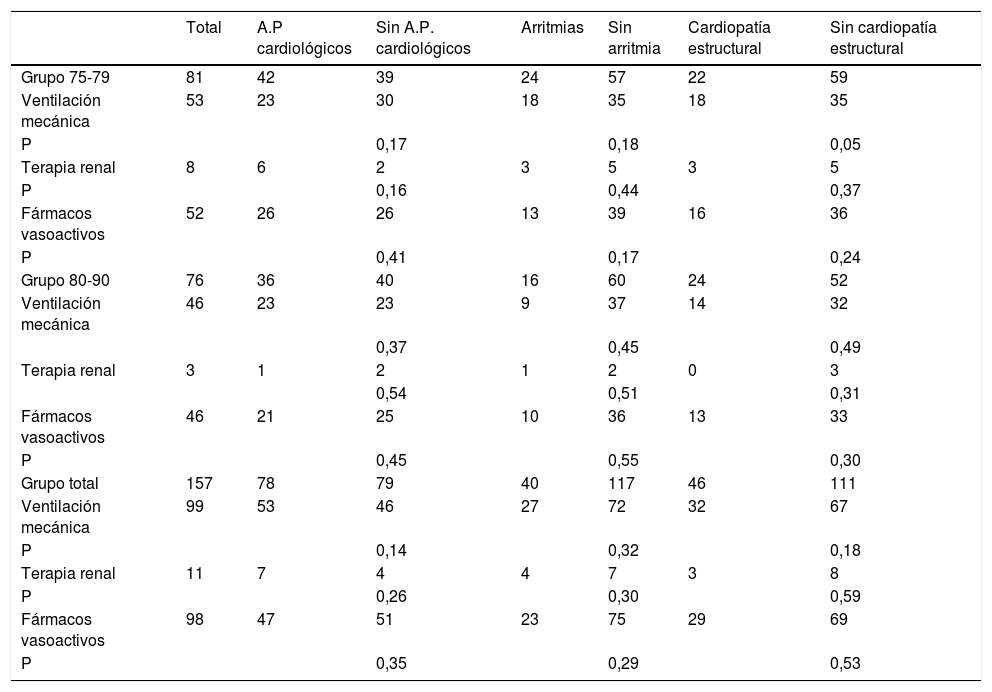Nuestro objetivo es analizar al paciente anciano en la unidad de cuidados intensivos.
Material y métodosSe realiza un análisis descriptivo comparativo retrospectivo de los pacientes mayores de 75 años que ya han sido ingresados, tratados y dados de alta de nuestro servicio durante el período de abril de 2013 y agosto de 2016. Se describe la incidencia de ventilación mecánica, terapia renal sustitutiva, fármacos vasoactivos y mortalidad. Posteriormente se compara el grupo de pacientes cuya edad se encuentra comprendida entre 75-79 años y 80-90.
ResultadosSe recogen un total de 157 pacientes mayores de 75 años (75-90). Un 45,9% mujeres (72/157), 54,1% hombres (85/157). Edad media 79,87 ± 3,6 (75-90). Índices de gravedad SOFA 8,21 ± 8,12 (1-80); APACHE II 20,84 ± 8,7 (4-47); SAPS II 54,7 ± 18,47 (2-100). Se objetiva mayor mortalidad en aquellos pacientes ancianos que requieren ventilación mecánica (P<0,001) y en aquellos que requieren fármacos vasoactivos (P<0,001). Al realizar un análisis estadístico comparativo entre el grupo de pacientes (75-79 años) vs. (80-90 años), no objetivamos diferencias significativas entre las medias de índices de gravedad (SOFA, APACHE II, SAPS II). Sí encontramos diferencias en cuanto a edad media en ambos grupos 76,98 vs. 83 (P<0,0001). No objetivamos diferencias estadísticamente significativas en cuanto a uso de ventilación mecánica, fármacos vasoactivos y terapia renal sustitutiva en ambos grupos. Tampoco se objetivan diferencias significativas en cuanto a mortalidad.
ConclusionesEl análisis comparativo entre enfermos de 75-79 años vs. 80-90 años no muestra diferencias significativas en cuanto a mortalidad, uso de ventilación mecánica, fármacos vasoactivos y terapia renal sustitutiva. El ingreso de pacientes más ancianos 80-90 años no equivale a peor pronóstico frente a los ancianos 75-80.
The aim of this study is to analyse the elderly patient in the intensive care unit.
Material and methodsThe aim of this study is to retrospectively compare the outcomes of patients over 75 years old. A comparison was made of the outcomes of patients who were 75 to 80 years old with those who were 80 to 90 years old, and who had been admitted, treated, and discharged from April 2013 to August 2016. The description includes the incidence of mechanical ventilation, renal replacement therapy requirements, the use of vasopressor drugs, and mortality. A comparison was then made between the two age groups (75-79 years and 80-90 years).
ResultsThere were a total of 157 patients greater than 75 years old at admission (75 to 90), of whom 72 (45.9%) were women, and 85 (54.1%) were males. The mean age was 79.87 years. The mean severity scores of the patients included were: SOFA 8.21, APACHE II 20.84, and SAPS II 54.7. A higher mortality was found in those elderly patients who required mechanical ventilation (P<.001) and in those needing vasopressors (P<.028). On comparing the two groups (75 to 79 years and 80 to 90 years), no statistically significant differences were found in the requirement for mechanical ventilation, vasopressors, or renal replacement therapy. There were also no statistically significant differences found in mortality when comparing both groups.
ConclusionsOn comparing the 75 to 79 years old group and the 80 to 90 years old group admitted to this intensive care unit, no statistically significant differences were found in mortality, use of mechanical ventilation, renal replacement therapy requirements, or use of vasopressors. The admission of patients aged 80 to 90 years old did not imply a worse prognosis when compared to those 75 to 85 years old in this patient sample.
Artículo
Socios de la Asociación de Medicina Crítica y Cuidado Intensivo
Para acceder a la revista
Es necesario que lo haga desde la zona privada de la web de la AMCI, clique aquí
Comprando el artículo el PDF del mismo podrá ser descargado
Precio 19,34 €
Comprar ahora













